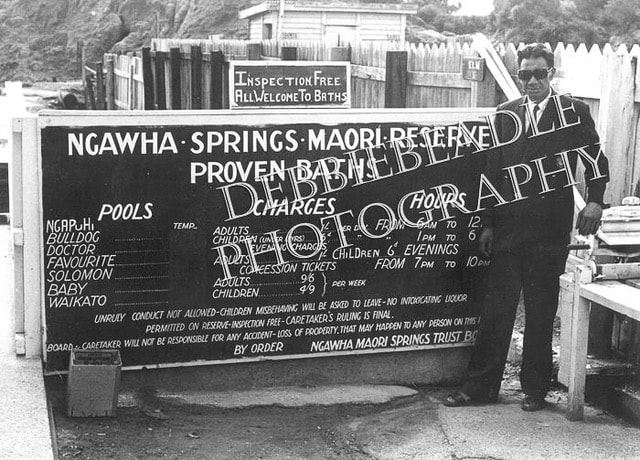our stories
Ko te Ngawha te kanohi o te taonga, engari ko tona whatumanawa, ko tona mana hauora, no raro
Ngawha is the eye of the taonga, but its heart, its life giving power, lies beneath (the surface)
The Ngawha Springs are iconic to the Ngapuhi iwi. They are culturally significant and have a rich social, environmental and political history. The Parahirahi Ngawha Waiariki Trust as kaitiaki has a responsibility to ensure that the springs are maintained and developed so that future generations can enjoy their healing waters.
brief historyMaori history tells how these hot springs are connected to the volcanoes in Hawaii thus supporting the genealogical Polynesian connections throughout the Pacific.
Historical accounts tell of Kareariki, an ancestress of the local Maori, who discovered the hot springs in the late 1600s. Kareariki lived with her husband, Uenuku-kuare, and their children in the area which at that time was covered in bush and rich in bird life. Kareariki later killed some of her female slaves who thereupon became taniwha in a nearby lake, collectively taking the form of a kauri log known to this day by the name Takauere. After Kareariki lost her pet dog Kaipahau (killed for food), she kept hearing his spirit barking night and day. He becomes another minder of the pools. It is said that only ancestors of exceptional mana can create or summon and control taniwha. Both Kaipahau and Takauere and other mokaikai (minders) have changed the whole characteristics of the pools in the eyes of Ngapuhi to more than pools of medicinal and personal value, indeed to objects of esoteric protection over the mana, tapu and wairua of the Ngapuhi people. land lossParahirahi Ngawha Waiariki Trust owns the one acre block upon which approximately half of the current Ngawha hot-pools complex sits and leases the other side (4 acres).
This is however, only a small portion of the original Parahirahi block (5,097 acres) which was aggressively targeted by the Crown for acquisition on behalf of settlers in the latter part of the 19th century. This process was encouraged by prospecting Europeans interested in exploiting mineral resources [mining, spa development, energy] and obtaining land. The five acres which had the hot springs on it was originally reserved from sale. So when the 4 acres (that is currently leased) was partitioned out, the original landowners did not believe they had sold that 4 acres. A number of unsuccessful petitions were made to seek the return of the 4 acres. By August 1935 nine of the 11 original owners in the one acre (Parahirahi C1) had passed and were not succeeded to. In order to protect the 1 acre, that they still held, from further alienation rather than appoint successors a committee of management was appointed to represent the original owners that retained the one acre – the Parahirahi C1 Trust. This is now the Parahirahi Ngawha Waiariki Trust. |
healing watersThe Ngawha Waiariki are healing waters. They heal physically and they have the ability to give sustenance to our wairua.
When Kareariki came upon the springs, she discovered their curative powers, particularly those giving relief to mothers with post-parturition pains. There is an account describing how a major conflict between two warring tribes took place on the West Coast. After the fight the two opposing forces came here to these hot springs to recover. Together these foes rested and bathed peacefully together. The springs unique properties soothed more than just the battle weary bodies. From time immemorial it is said, the hapu of Ngapuhi and beyond have attended the springs of Ngawha to partake of their healing powers. The first European came to these pools in 1842. They also considered the pools to have healing properties. In 1876 they erected a bathhouse in the area. This before there was any properly formed access to the springs. kaitikaitangaKaitiaki are the guardians of the Maori world. The kaitiaki for Ngawha and some of the waterways of Ngapuhi is a taniwha named Takauere. The springs, streams, rivers and lakes are all a part of his body; Lake Omapere being his heart and belly, Ngawha his eye and head, with his major limbs being the Waitangi River to the east and the Utakura and Waima rivers to the west. The numerous springs throughout the north are regarded also as indications of his presence.
The Utakura and Orukiruki waters find their way to the Hokianga and the Waipapa waters find their way to Waitangi – and wherever the waters flow, the relationship of tangata to whenua and of tangata to tangata is is implicit. Thus the presence of Takauere unifies nga hapu of Ngapuhi-nui-tonu. There is interconnectedness between not just water bodies above and below the earth’s surface, but also between ancestors and the people of today. Kaitiaki responsibilities do not solely reside with Takauere. There are complementary roles held by tangata whenua. Kareariki’s descendants uphold the mana of the kaitiaki of this tribal taonga (treasure) through the Parahirahi Ngawha Waiariki Trust. They along with Takauere, a spiritual being, ensure that the pools are here for the benefit of all. |
Proudly powered by Weebly

